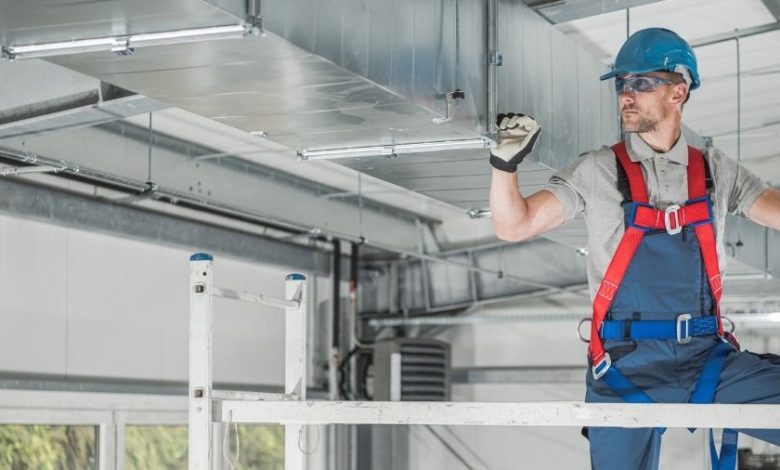How BIM Model Help in HVAC Installation during construction?

In order to implement BIM, mechanical contractors must train their staff on Revit design, Revit detailing, and BIM models. BIM training is “normalized” training, a topic that was discussed in a breakout session of the MEP Force 2020 Virtual trade organizations conference. As the driving force of BIM adoption, mechanical contractors have realized the biggest benefits. This article looks at the benefits of BIM in HVAC installation.
For a construction project, Architectural BIM Services improves communication and cooperation throughout the entire process, from pre-construction to the final construction phase. BIM models enable HVAC to plan with the rest of the building’s structural elements, ensuring that it is efficiently built. Because the BIM model can be used throughout the building’s lifespan, it is easy for engineers to view the entire HVAC system’s location, including any ductwork.
Using BIM in HVAC installation can help improve the efficiency and profitability of your construction project. A 3D BIM modeling can help you accurately determine the size and configuration of HVAC components. It also helps you plan the overall installation sequence of various components. Building information models can also help you make smarter decisions, enabling you to maximize your profits. BIM software supports pre and mid-construction processes, and it also assists with day-to-day operations.

BIM software helps designers and contractors create an intelligent 3-D model of the construction project. This model provides valuable information to the entire team, including the management team. By analyzing the BIM model, they can determine potential design challenges and avoid costly mistakes. They also help them communicate and coordinate with each other in an efficient manner. The building manager can make strategic decisions based on the data. In addition to helping designers and contractors, BIM software also helps maintain safety and improve efficiency.
A significant benefit of HVAC BIM modeling is the ability to design the entire HVAC system before the building is constructed. The software makes it possible for engineers to quickly run HVAC load and performance calculations without guesswork. As an added benefit, specialized software allows designers to swap out different equipment with ease, resulting in better design and less work. Additionally, a single model can be used to update the entire project’s drawings automatically as new changes are made.
In addition to reducing construction costs, HVAC BIM modeling also enables contractors to manage their field operations by ensuring that there is no clashing between drawings and models. A clash-free 3D model will also reduce rework, which is crucial for keeping costs under control. HVAC construction projects are notoriously expensive and complex, and contractors are constantly under the gun to finish the job. Unfortunately, clashes in models and drawings will result in errors during installation. Moreover, due to the high amount of information that must be shared between HVAC contractors, cost overages can easily occur.
A third benefit of HVAC BIM is that it helps contractors make better decisions. Creating 3D HVAC duct systems allows contractors to reduce the number of changes and reworks. With accurate models, HVAC contractors can develop realistic, efficient designs and build them efficiently. HVAC BIM models also allow for detailed extraction of construction data, which is essential for contractors. These benefits can translate to more productivity for building owners. With HVAC BIM modeling, contractors can reduce their costs and complete projects in a fraction of the time.
Another benefit of HVAC BIM modeling is the increased accuracy of the models. BIM specialists can leverage the flexibility of Revit data with the Smart Client extension. By applying Revit parameters to ARCHIBUS tables and fields, they can create a comprehensive HVAC system model. Furthermore, BIM specialists can plan for the synchronization process between Revit and ARCHIBUS models. As a result, synchronization of the models is faster and more accurate than ever. This is also beneficial to the mechanical contractors because it enables them to fabricate and install HVAC systems faster, thus increasing their profit margins.
HVAC systems account for up to 35% of a building’s energy cost. Additionally, HVAC systems can be complex to design, fabricate, install, and manage, requiring multiple contractors to work together. Lack of coordination and planning between contractors can create multiple challenges during construction. Using HVAC BIM models has significant benefits for mechanical contractors. They have increased efficiency of systems, improved schedules, and reduced errors. With BIM software, contractors can develop more innovative designs for buildings.
Building simulations can provide accurate energy use estimates and can also calculate zone conditions to optimize occupant comfort. The detailed HVAC models paint a realistic picture of the building’s performance in actual use. Moreover, they can provide valuable feedback for project decision-making. The goal of HVAC BIM modeling is to provide a realistic picture of a building’s performance, thus guiding the decision-making process. It can be an excellent directional strategy to save energy and reduce costs.
What are the advantages of a BIM model for HVAC installation? The short answer is: that it helps reduce costs, improve coordination, and detect clashes. Listed below are just a few of these benefits. This article will examine each of them. Hopefully, these benefits will convince you to give it a try. But don’t just take our word for it. Read on to discover more.
Reduces costs
By using a 3D model, HVAC contractors can collaborate more efficiently on projects, which can significantly improve construction productivity. MEP BIM Services can also improve building performance by streamlining design and installation processes. In addition to increasing construction efficiency, the 3D model can reduce costs in HVAC installation. The advantages of BIM can be seen in the following ways:
The benefits of a 3D model are numerous. It is ideal for industrial plants with complex equipment, such as MEPT systems. By using BIM, engineers can create 3D as-built drawings, which eliminates the need for costly field changes. In Stanley’s case, a BIM model reduced the cost of a new construction project. The company expanded a grain-handling facility in western Indiana, constructing a new structure in between the existing buildings, pipe racks, and electrical substations.
Shortens installation time
Commercial HVAC companies typically have BIM/CADD departments to improve the coordination and fabrication of HVAC systems. Using BIM technology, HVAC contractors can shorten their installation time while ensuring the correct fabrication and installation. It also shortens the overall project timeline and prevents costly errors from occurring. By incorporating BIM technology into the construction process, HVAC companies can ensure the highest level of efficiency for their clients. BIM helps to reduce the number of errors, it is increasingly becoming a standard practice and is mandated by many regulatory bodies.
HVAC systems account for up to 35% of building energy costs. But they are notoriously difficult to design, fabricate, and install. Using uncoordinated effort from mechanical contractors can cause multiple challenges throughout the construction process. BIM software and processes help mechanical contractors overcome these issues and improve their overall efficiency. According to a study by Dodge Data and Analytics, HVAC contractors who use BIM technology enjoy significant improvements in schedule, quality, and efficiency.
Detects clashes
Detects clashes in HVAC installation projects by identifying conflicting elements or areas prior to construction. Clash detection tools leverage 3D models to identify conflicts and coordinate the design of a building. Using this software can eliminate conflicting items, streamline the installation process, and promote collaboration between disciplines. Clash detection tools also stimulate critical conversations earlier in the process. Listed below are the advantages of using clash detection tools in HVAC installation projects.
Detecting clashes is the key to an efficient installation. Navisworks can help with this process by automatically identifying potential conflicts between HVAC installation and a sprinkler system. In some cases, a supply duct can clash with the main pipe for a sprinkler system. Clashes in HVAC installations can occur during construction due to the way the ducts are arranged. Detecting clashes during the design process allows the HVAC installation team to make an informed decision about the proper installation method.
Improves coordination
Coordinating MEP components during construction is crucial in order to meet schedule and budget requirements. A coordination drawing helps prevent costly construction overruns by clearly depicting the horizontal and vertical dimensions of each system and how it may interfere with the other systems. It helps coordinate the routing of HVAC ductwork and other building systems, including plumbing and process pipes and instrumentation cable trays. These coordination drawings also facilitate building system fabrication and installation, making the process faster and more efficient.
When integrated into MEP designs, contractors can ensure the right placement of HVAC equipment, electrical conduit, ceiling, elevations, and support systems. During construction, coordinated workflows reduce waste and increase safety on the job site. An MEP integrated design can also increase design quality, as 59% of contractors believe coordinated workflows lead to improved design outcomes. Additionally, coordinated 3D models enable real-time modification tracking, and Revit can provide access to updated content.
Related also, What is Furniture Architectural Drafting?





